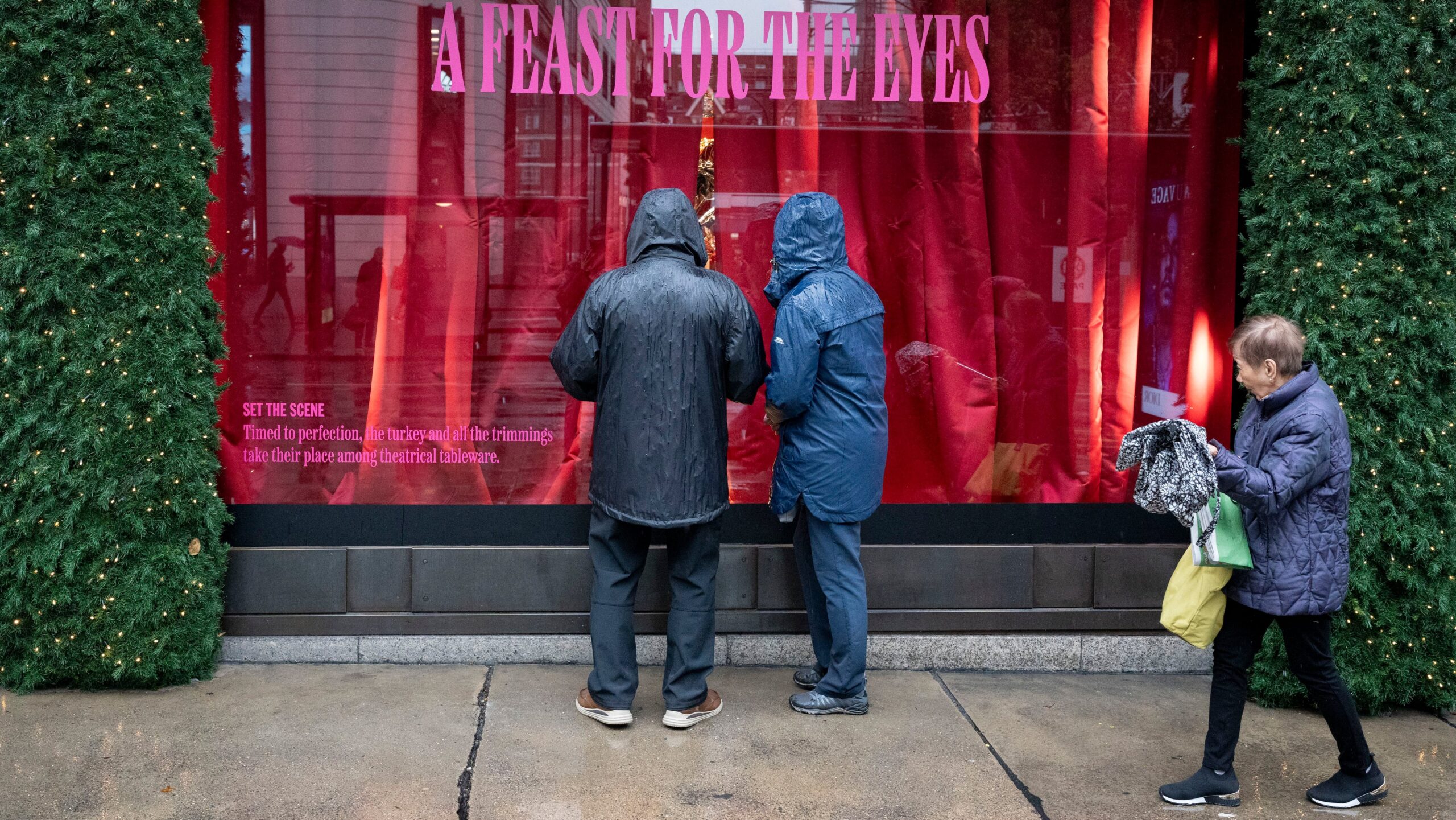
Again and again over the past two years, consumers defied predictions that they’ll stop spending. This time around, it might come true.
While analysts predict an uptick in sales from last year, the rate of growth will be slower and the overall volume of goods sold will likely be smaller. It’s a departure from the surprisingly resilient consumer economy seen in the US, fashion’s biggest market.
The US National Retail Federation forecasts holiday retail sales, defined as the period between November through the rest of the year, to grow between 3 percent and 4 percent this year, to about $960 billion, which accounts for inflation. That reflects a deceleration from last year’s 9 percent rise and 2021′s explosive 12.7 percent growth.
A modest increase will not be a reflection of heightened demand but rather an effect of continued inflation. In other words, shoppers will turn out this season and stomach the higher prices, but only because they have to. And they certainly won’t be treating themselves to extra gifts.
“Spending is going to be up, of course, because everything is more expensive,” said Rebecca Duval, retail analyst at Bluefin Research. “But if you look at it from a unit perspective, everything is down significantly. When I’m out and speaking to consumers, people are feeling it, the pinch of everything costing them so much.”
This new normal is already settling in. US retail sales in October fell 0.1 percent from the prior month, breaking a six-month growth streak during which the economy expanded nearly 5 percent, the fastest pace since 2021, largely driven by consumer spending. But shoppers now are finally seeing their savings dwindle and credit card debt accumulate as they start to reject sticker shock; consumer confidence dropped to a five-month low in October.
Retailers have reacted accordingly, by forecasting downward sales and aggressively marking down products to drive sales. Macy’s, for instance, expects its annual revenue to fall 6 percent to 7 percent this year; Target announced in its third-quarter earnings that it anticipates in-store sales in the fourth quarter to fall in the mid-single digits. Meanwhile, Burberry announced last week it won’t be able to meet its full-year revenue target if demand continues to slide on its current trajectory.
Meanwhile, Black Friday markdowns have begun early — a tactic to offload slow-moving merchandise. According to Adobe Analytics, discounts are already ramping up to break records, with an average of 25 percent markdown in apparel compared to 19 percent last year.
“Convincing people to pay up for things will be in the rearview,” said Simeon Siegel, analyst at BMO Capital Markets. “That was a blip through the pandemic.”
A number of forecasts project very little growth in spending after adjusting for inflation.
Shoppers will buy fewer items this year and seek out promotions, according to multiple consumer surveys. A Deloitte report found that while spending will rise about 14 percent compared to 2022, gifts lists are shorter, from nine presents to eight.
“Customers are factoring in inflation,” said Brian McCarthy, principal at Deloitte. “They’re saying, ‘Hey, I’m going to spend a lot more this year, I just know that’s going to get me less.’”
As a result, respondents also said they’ll be looking for promotional events, with 66 percent this year stating their intention to purchase during Black Friday weekend, compared to only 49 percent last year. McKinsey’s holiday survey, meanwhile, found that fewer people are planning to splurge on gifts this year: 35 percent versus 39 percent in 2022.
“People are heading into the new year thinking inflation is bad, interest rates are tough, there’s geopolitical conflict in the world, and that’s why consumers are so negative,” said Kelsey Robinson, senior partner at McKinsey. “They’re in betwixt, and their uncertainty is what’s keeping them from splurging.”
In reaction to the sky high prices this year, shoppers are on the hunt for value — even if that means trading down.
This is evident by the stellar performance of off-price retailers TJX Companies, which owns TJ Maxx, TK Maxx in the UK and Marshalls stores, and Ross Stores Inc. TJX third-quarter sales rose 9 percent to $13.3 billion, the company reported Wednesday, while raising its full-year profit guidance. Ross, meanwhile, saw sales increase about 7 percent to $4.9 billion in the same period, and also projected strong holiday season earnings.
“Off-price is a value proposition so they might be in the best position right now,” said Duval. “Consumers are seeking value, so I think they’ll continue to reap the benefits.”
Personal care and beauty will also be strong categories this holiday season because these products are far more affordable compared to clothing, footwear or handbags, according to retail consultants. Mini-sized beauty products, for instance, have dramatically grown in popularity at stores like Sephora and Ulta.
Alongside off-price, resale companies might also be in a position of strength this holiday season as consumers look for deals. Sites like The RealReal, Fashionphile and even eBay allows users to filter by condition of products, including new with tags.
“You’re seeing so many brands launch reused sections on their websites, and I think that is a subcategory that will continue to grow this holiday season,” said Tierney Wilson, senior vice president at January Consulting.
The holidays aren’t hopeless. Brands can convey a sense of value to consumers by emphasising quality over price, or other differentiated offerings, such as convenience or speed.
“It’ll be really important for brands to communicate to customers how it sticks out,” said Wilson.
“Its value could be saving me time, being able to order it last minute or browse online and the localised inventory is accurate so I can buy it in-store.”
It’s also important to be clear and concise in marketing materials, Wilson added. “Lean into one thing, and not be everything to everyone,” she said. “That way, you’re clear on who the target customer is.”
Any kind of targeted deal or promotion will go a long way. To boost sales as well as margins, brands should consider personalised promotions rather than offering discounts en masse, according to Robinson, of McKinsey.
By leveraging consumer purchase histories, retailers can identify for instance the customers who only purchase when there is a sale and customers who will transact regardless of price. Withholding discounts from the latter then would result in higher margins.
“Maybe I’ve purchased with you three times in the past, but if you gave me a promo this year, it would pull incremental sales from my wallet that was going toward another retailer,” said Robinison. “You have to test out where promo dollars will have the highest ROI.”
What’s ahead in 2024?
This year, retailers have been able to maintain heightened profit margins despite weaker sales, because transportation costs have plummeted since pandemic-era bottlenecks. Freight costs have dropped as much as 90 percent since 2022, and retailers from Gap Inc. and Macy’s to Costco and On Running have cited lower freight rates as a driver of year-over-year margin improvements.
But come next year, this tailwind will disappear, according to Duval, while consumer spending will likely continue to cool. “There’s a little bit of magic going on right now and it’s actually worse than what people realise,” she said. “That’s going to be a big reveal next year.”
On the other hand, the consumer economy has been far more resilient than anticipated. The much-feared recession has not happened, and economists agree that the likelihood of a recession in 2024 is slim. Goldman Sachs named the odds at 15 percent in a report published Thursday.
As inflation has moderated in recent months, signs are pointing to the so-called soft landing that the Federal Reserve has been aiming for, economists say, and this could result in interest rate cuts as early as next year.
There’s always a lag between inflation moderation and the perception of shoppers, according to Deloitte’s McCarthy. This means that while consumer sentiment is at a low point right now, it will recover in time as long as inflation continues to ease.
“As long as employment stays strong and inflation levels out, customer sentiment which is how they perceive the economy and how they want to spend will also improve,” he said. “Starting next year, customers should feel more upbeat.”



